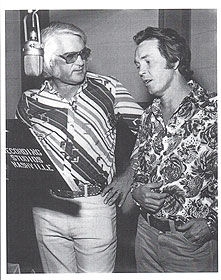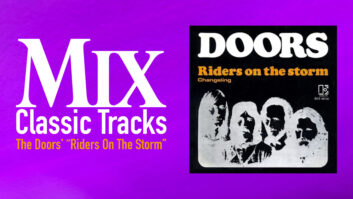
Charlie Rich had made the rounds. He’d joined and left several labels by the time he signed with Epic in 1967 on the recommendation of producer/executive Billy Sherrill. He’d worked as a session musician, playing piano for Judd Phillips’ Judd Records, and then for Judd’s brother Sam at Sun Records and the Phillips International label, where he also wrote and recorded a few cuts of his own, including the Elvis-esque hit single “Lonely Weekends.” And he’d done “Big Boss Man” for RCA/Groove and “Mohair Sam” for Smash Records.
But what characterized the first decade or so of Rich’s career was not so much his successes as the difficulty he had in finding a musical home stylistically. Rich’s talent for playing jazz and R&B-style piano didn’t necessarily fit at the hit-making country and rock ’n’ roll labels in the South at the time. He was just a bit smooth for then-current tastes. In fact, Sam Phillips was reputed to have rejected Rich on first listen, handing him a stack of Jerry Lee Lewis records and saying, “Come back when you get that bad.”
But Rich found that musical sweet spot with Sherrill, whose “countrypolitan” production seemed to fit the singer just right.
“To me, those Charlie Rich sessions were so special,” recalls Lou Bradley, who engineered and mixed the album Behind Closed Doors. “Particularly on the Kenny O’Dell song ‘Behind Closed Doors,’ all forces came together for him and for that song.”
As they had done many times before, Bradley and Sherrill recorded Rich live with a band of A-list Nashville session musicians in the famed Studio B at the Quonset Hut built by legendary Nashville producer Owen Bradley and his brother, guitarist Harold Bradley. Lou Bradley (not related to Owen and Harold) says that working with Rich marked a turning point in the way Sherrill worked with singers in general, for better or worse.
“It started before this particular session, on a session when we did another Kenny O’Dell song, ‘Take It on Home,’” Bradley recalls. “Charlie was a piano player, and he would sometimes sing and play. If [Hargus] ‘Pig’ Robbins was on that session and Charlie wanted to play and sing, Pig would move over and play Rhodes or organ, or drink a cup of coffee. But most of the time, Pig played the piano and Billy felt that Charlie ought to be by the piano anyway, so we moved him down there. There was a real good spot at the other end of the room for vocals, but I knew this was the hand I was going to be dealt.”

So working with Rich inaugurated an era of Sherrill recording all vocalists beside the 7-foot Steinway in B, and this is one of the reasons Rich’s sessions are so memorable for the engineer, almost 40 years later. He can still picture the band setup. (See illustration.)
“The straight side of that piano, the bass side, was pushed up against a low divider between it and the drums—Jerry Carrigan was the drummer on that session,” Bradley says. “Later, we made that wall higher, but at that time it was no higher than the piano. Henry Strzelecki’s [electric] bass was also next to the piano—the bass and drums were under a shed that came out—and behind the piano and by that bass was a 6-string tic-tac bass guitar; Tommy Alsup played that.”

Rich stood very close to Robbins, at the front corner of the piano to Robbins’ right, with backing vocalists positioned near him. The rest of the room was nearly full of guitarists: two acoustics close to the rounded end of the piano, and electric guitar and pedal steel across from them, on the opposite side of the tracking room from the drummer. Pete Drake played steel on the Behind Closed Doors sessions; other guitarists included Jerry Kennedy, Billy Sanford and Pete Wade.
Recording to a 16-track Ampex MM1000 machine through the custom Columbia console, Bradley had developed a standard mic setup for most of the musicians: He took the electric bass with two DIs—one off the bass and one off the amp—and blended those. One Neumann KM84 on each captured acoustic guitars, piano and stand-up bass, and a U67 was used for electric guitar. On drums (the Studio B house drum kit and a snare nicknamed “Old Red” that Carrigan brought to the sessions), Bradley used mostly Neumann mics: KM84s on snare and hi-hat, U67s overhead and KM84s on toms, plus an Electro-Voice RE-20 on kick drum.
For Rich’s vocal, Bradley chose a different mic from the usual U67 or U87 he would have used on other singers he and Sherrill recorded (George Jones, Tammy Wynette, Andy Williams, Tanya Tucker, etc.). “I cut Charlie on a U49,” Bradley says. “Charlie made a lot of lip sounds and mouth sounds, and a 67 or 87 or 47—that type of mic—has a sharper spike at the top end right in that range, but the 49 or the 249 had a gentler curve up at the top, and Charlie sounded so good on it. He was such a good singer anyway.”
Because of Rich’s position in the center of the band, Bradley says he had to develop a few tricks to deal with excessive vocal leakage: “One was to use a little slapback, very subtle sometimes, at the point that was causing the problem,” he explains. “And sometimes I put the slapback on something other than the vocal, and it would cause a little distraction; you had to make something happen in that empty space where you had the leakage from the vocal, either in the piano or the guitars or background. But most of the time we could deal with it. If you listen real close to the old record, you’ll hear [that leakage] just a little, but it didn’t hurt that record at all.”

Engineer Lou Bradley (left) with songwriter/producer Norro Wilson, who co-wrote “The Most Beautiful Girl,” which appears on Behind Closed Doors
Bradley also has great memories of the musicianship on those sessions: “Bill Sanford is such a great player,” he says. “He’s still working, and he’s always had that great talent as far as what a session musician should do when they don’t have the ball. This isn’t a guitar song with guitar leads or predominant guitar parts. But Billy [Sanford] would fool around and find out what he could do to contribute so that if you turned his track off, you’d wonder where the record went. And I think this record is a good example of that. He’s in there, he plays a little run every once in a while, a dip in the bridge—just real simple. He could play great leads, but I was always impressed with what he’d do when the ball wasn’t in his court because this song was predominantly Robbins on the piano.
“I asked Pig the other day,” Bradley continues, “I said, ‘I’m going to be interviewed about “Behind Closed Doors”; you got anything to add?’ He said, ‘I don’t know. I was a little nervous and scared with Charlie, who was such a great piano player, standing right there beside me singing in my ear.’ But Pig said, ‘I tried to be me and think a little bit like Charlie, because Charlie had a style that leaned toward blues.’ I think Pig set the mark real high with what he played on this record.”

Like all of Sherrill’s countrypolitan records, “Behind Closed Doors” included strings that helped create the drama in the arrangement without overpowering the song. Bradley recorded an 11-piece string section (violins, violas and celli) in B. “Bill McElhiney wrote those strings,” Bradley says. “Billy would get together with the arranger he’d use, and he’d hum or play lines he wanted the strings to play. You know, Billy was a good piano player and McElhiney knew what he wanted.
“I’d use two overheads on the violins—from time to time, either 47s, 67s or 49s. And I liked the KM86; it looked like the KM84, but it had the capsule on the end with switchable pattern and the sound of that mic was similar to the 49. A lot of times for strings, you’d get a real warm sound, and if they did a gliss up, 47s or 67s had that spike on top that would make them jump out more than they should have. But I’d use a 67 or 87-type mic on the violas, and stereo-mike the two celli with KM84s fairly close, in an ‘X’ position so they’d add up, and I might put a little limiting on the celli. We had some good UA limiters and some Teletronix ones, too.”
McElhiney’s string arrangement was one of two elements that were overdubbed onto this mostly live track. The other was Rich’s vocal on a rewritten last verse. Bradley says that in O’Dell’s original song, the last verse was originally “kind of mild. They went behind those closed doors and you thought they might’ve held hands.” Sherrill reworked that last verse to give the song a little more heat, and as Bradley says, “The revamped lyric was more to the point, and it made a good song better and stronger.”
Thanks to the way “all forces came together,” as Bradley puts it, “Behind Closed Doors” rose to Number One on Billboard’s Hot Country Singles chart in 1973 and reached Number 15 on the Hot 100. The crossover hit also earned Song of the Year and Single of the Year Awards from the Country Music Association and the Academy of Country Music, and Rich received a Grammy for Best Male Country Vocal Performance. “Behind Closed Doors” and “Most Beautiful Girl in the World,” also on the album, continued to be signature songs for Rich whenever he performed, until he passed away in 1995.
Bradley still lives in Nashville, but he flies out to California a few times a year to record Merle Haggard, who’s now his main client. His memories of Studio B and working with Sherrill—who’s now retired—are fond as well as vivid: “What was so great about Billy was he knew how to make a band play to work with that singer. My job as the engineer was just to capture that. A lot of people thought Billy used dynamics just to use dynamics, but he was really doing the dynamics to make the song come across. I think he was one of the best at cutting country ballads that ever was.”







